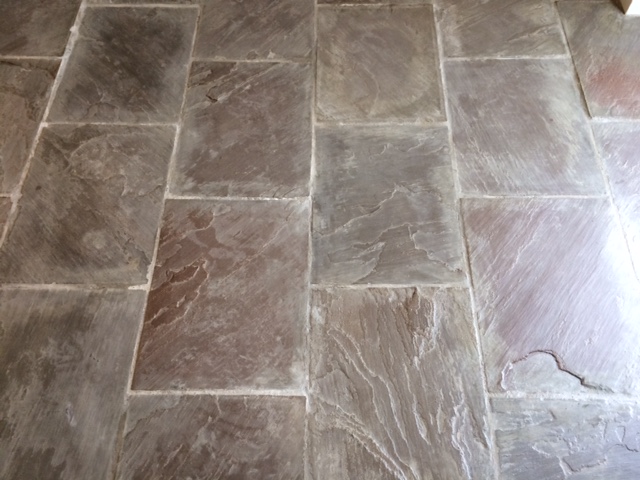This Indian Fossil Sandstone tiled floor in Skipton was in a terrible state. Indian Sandstone, sometimes known as Indian Sandstone Flags, are an alternative to Yorkshire Sandstone (or ‘Yorkstone’), which is known for being particular hard wearing and high quality.

Nonetheless, the problems with the floor were not due to the quality of the stone, per say. Rather, the floor’s poor condition was caused by a lack of sealer, allowing the floor – and by extension the entire house – to become very dusty. In addition, the grout lines had been pointed with cement and sand instead of normal grout, which simply made the floor look messy and poorly cared for.

I was called down to the property to set the situation right by providing a deep clean and fresh seal.
Cleaning an Indian Fossil Sandstone Floor
I started the job by dealing with the unsightly cement splashes around the grout lines, breaking them down manually using a good old fashioned hammer and chisel.
Nonetheless, my main concern around the grout lines was the grout haze caused by the excess cement. To neutralise the haze I carefully treated the grout lines with a phosphoric acid cleaner known as Tile Doctor Grout Clean Up, this product removes mineral deposits such as excess cement leaving the surface looking a lot tidier. The floor was then rinsed with water to remove the acid cleaner.
To round off the cleaning process, I mixed a solution of one part Tile Doctor Pro Clean to four parts clean water, before applying it to the tiles and scrubbing it in with a black pad fitted to a rotary machine. This helped to remove the ingrained dirt caused by a lack of sealer and clean the area ready to receive a fresh seal.
Sealing an Indian Fossil Sandstone Floor
I left the property to allow the floor to dry over night. Upon my return the next day, I checked for excess moisture and, once satisfied the floor was dry, I proceeded to seal the floor with four coats of Tile Doctor Seal & Go.

Seal & Go is a water-based topical sealer designed to build up stain resistant protection on the surface of the floor and to allow moisture vapour transmission. It is typically used to seal internal, unsealed porous surfaces, including Sandstone, Quarry and Victorian tiled floors.

Given the awful original condition of this floor, the results achieved over the space of two days were very good. Certainly my customer was very pleased with the transformation. The addition of a robust surface seal will go a long way to ensure the floor doesn’t fall back into such a bad state again.
Source: Sandstone Tile and Stone Cleaning and Maintenance Service in North Yorkshire
Tile Doctor is the largest Tile and Stone network in the UK, whatever and wherever your problem, give us a call on 0845 652 4652.